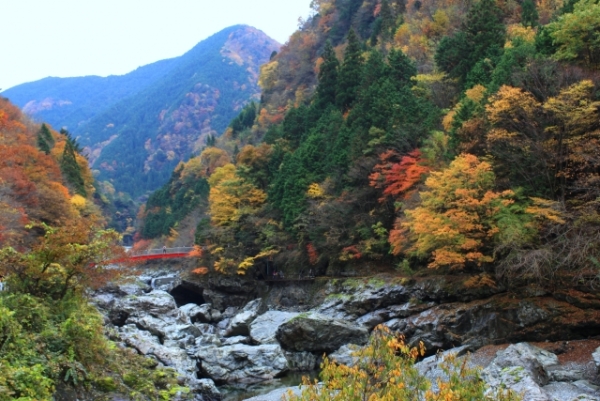Hiking under the fall leaves of Nara's Mitarai Valley

Over the hills and mountains, away from the urban areas of Osaka and Kyoto, lies Nara Prefecture’s (奈良 Nara-ken) peaceful Mitarai Valley (御手洗渓谷 Mitarai Keikoku). This deep canyon is cut sharply by the confluence of two rivers, the Sanjogawa River (山上川) and the Tennokawa River (天ノ川), whose headwaters both begin in the sacred grounds of the Shugendō (修験道) in the Omine Mountain Range (大峰山脈 Ōmine Sanmyaku). Around the beginning of November, the emerald waters of the valley’s rivers strike a beautiful contrast with the fiery fall foliage along their banks. The valley is a well-known day trip location for seeing fall leaves. It only takes about two leisurely hours to hike the relatively flat length of the valley. Nothing more is required than some good walking shoes and a light jacket for the cool mountain breezes blowing through the valley. Along the hike, you’ll walk under the lofty boughs of primaeval trees, cross shaky suspension bridges, see grand waterfalls, ponder peculiar rock formations, and be soothed by the calm but sometimes roiling sounds of the river below.
Getting to the trailhead

The Tennokawa River in autumn. (Image credit: photoAC)
Begin your hike by taking the Kintetsu line (近鉄線 Kintetsu-sen) to Shimoichiguchi Station (下市口駅 Shimoichiguchi-eki), and transferring to the bus just outside the train station heading to Tenkawa Kawai Bus Stop (天川川合バス停 Tenkawa Kawai basu tei) in Tenkawa Village (天川村 Tenkawa Mura). Enjoy the ride, as it takes about 1 hour and 10 minutes. From the bus station, turn right at the only traffic light in the village, and walk down the road until you reach the Tenkawa Village Information Centre (天川村総合案内所 Tenkawa Mura Sōgō Annaishō), and pick up a free map for the 2-hour hiking course.
Beginning the hike

The suspension bridge leading to the trailhead. (Image credit: Tamago Moffle / CC BY-SA 2.0)

The entrance to the hiking trail. (Image credit: photoAC)
Map in hand, the hike can begin. From the information centre, it’s 1.2km and about 20 minutes through the village until the start of the forest path. Begin by crossing the creaky suspension bridge and follow along the riverside until you find the entryway labelled Mitarai Yūhodō (みたらい遊歩道) in Japanese, welcoming you to the start of the trail.
Take a short break

Mitarai Kyūkeisho Rest Area (Image credit: photoAC)
After about 25 minutes (1.6km) of walking you should reach the Mitarai Rest Area (みたらい休憩所 Mitarai Kyūkeisho) after crossing another bridge where you can stop for a break, hit the restroom, and have a drink before continuing on with the second half of the trail.
The famous Mitarai waterfalls

Mitarai no taki waterfall (Image credit: Julien Manchuelle)
Immediately after the rest area you’ll cross a long bridge and find two of the biggest landmarks of the hike, the Mitarai Waterfall (みたらいの滝 Mitarai no taki), and the Hikari Waterfall (光の滝 Hikari no taki). Both are quite impressive and secretly hidden away in the forest.

Hikari no taki waterfall (Image credit: photoAC)
Hike through the forest to Dorogawa Onsen
After about 40 minutes (1.8km), you’ll reach the end of the hiking path and travel alongside a paved road until you reach the entrance to the next part of the trail. This portion of the trail takes about 50 minutes (2.8km). The path takes you through the forest and is a little hillier than the first half. The trail ends in the quaint onsen town of Dorogawa (洞川温泉 Dorogawa Onsen).
Dorogawa Onsen


Walking into Dorogawa Onsen Town. (Image credit: Julien Manchuelle)
Dorogawa Onsen has 15 ryokan (旅館) inns with hot spring baths. Staying overnight is the best way to take in the relaxing atmosphere of this picturesque mountain retreat. The Kadojin (角甚) and Koryokuen Nishisei (光緑園 西清) are especially beautiful traditional ryokan. For those that need to get back early, be sure to check the return bus times at Dorogawa Onsen Bus Stop (洞川温泉バス停 Dorogawa Onsen basutei) as the buses are few and infrequent. If you still have time, you can soothe your legs and body by soaking in one of the many baths here just as the ancient Japanese mountain ascetic hermits, the Yamabushi (山伏), have done since long ago. If you’re lucky, you may even spot some of the pilgrims in their white robes and deerskins carrying conch shell horns. Either way a walk under the colourful fall leaves of the Mitarai Valley will put you in touch with the true spirit of autumn in Japan.
Header image credit: photoAC





